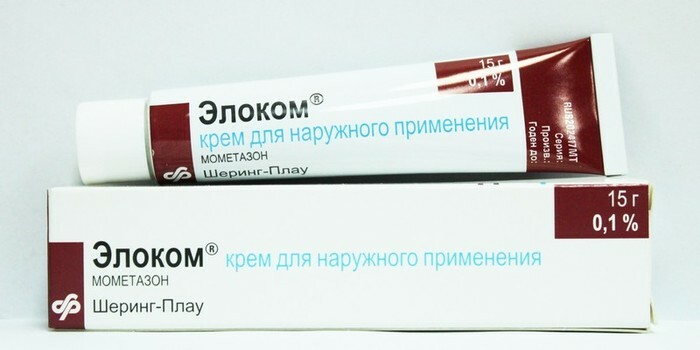Content
- How does it affect the body
- Symptoms of increased performance
- Diagnostic methods
- During pregnancy
- Drug therapy
- Folk remedies
- Diet
- Consequences of high testosterone in women
- Video about high testosterone in women
Increased testosterone in women indicates diseases that can be identified by additional symptoms. The hormone is important for the reproductive system, muscles, bones and the work of the sebaceous glands. But in large quantities, it is produced only in men. Therefore, in women, its increase indicates health problems.
How does it affect the body
In women, testosterone is produced by the ovaries, adrenal glands, but in small quantities. The level of secretion depends on age. The highest production activity is observed before the age of 30, and after 50 it begins to decline. The male hormone is of three types, active, participating in biological processes - free.
| Testosterone | Peculiarities |
| Free | It is contained in the body from 1 to 3% of the total concentration of the hormone. But free testosterone is the most active, it acts on cells, causing certain biological processes. |
| With albumin | It accounts for about 44% of the total norm. As a result of the connection with albumin, the biological activity of testosterone decreases, but does not reach zero. This connection is weak, easily destroyed. |
| With globulin | It accounts for approximately 54% of total testosterone production. But unlike the bond with albumin, the bond with globulin is very strong and difficult to break. Therefore, this symbiosis is called transport symbiosis. But the ligament does not have activity. |
If a woman has a small amount of the male hormone, then this does not have a negative effect on the body.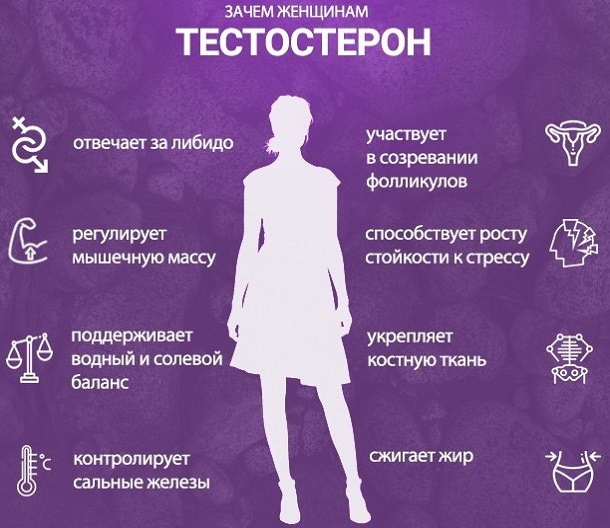
Testosterone is necessary for him, he participates in many biological processes:
- skeletal development;
- balance of muscle and fat mass;
- the formation of follicles in the ovaries;
- secretion of gonadotropins;
- responsible for sexual activity;
- the functioning of the sebaceous glands;
- the formation of subcutaneous fat.

The norm of testosterone in the female body ranges from 0.45 to 3.75 nmol / l. It depends on the state of health, the correct functioning of the internal organs, age, and pregnancy. Therefore, the rate is determined according to the table. The increase in the concentration of the male hormone may be due to a genetic factor.
Symptoms of increased performance
An increase in testosterone in women more often occurs during the period of bearing a child, menopause, and infertility.

An increase in the concentration of the male hormone is additionally accompanied by symptoms:
- The menstrual cycle is disturbed. It becomes short, and the discharge is scanty. Sometimes menstruation disappears completely.
- Body hair growth. Excessive vegetation appears in places uncharacteristic for the female body - legs, arms, chest. In this case, the hairs are hard, dark. Sideburns or a beard, mustache may begin to grow on the face.
- Alopecia. Baldness begins in the male pattern - from the top of the head.
- Changing the figure by increasing the body fat. The physique becomes similar to that of a man. The size of the breast decreases, a "beer" belly appears, a fat hump on the back under the back of the head. In this case, the arms and legs can remain thin.
- Increased endurance. A woman becomes stronger, more active, she can lift weights, which she was not capable of before.
- Deterioration of the skin condition. It can become very oily or dry with breakouts. Sometimes the skin cracks, begins to peel off. The work of the sebaceous glands is disrupted, a blockage of pores is formed, and acne occurs.
- Change in mood. Since an increase in testosterone concentration disrupts the hormonal background, the psychological and emotional state changes. The woman becomes irritable, nervous, sometimes aggressive. Sleep is often disturbed, and persistent depression occurs.
- Voice change. He becomes low, coarse, like a man's.
- Polycystic. These are benign growths in the ovaries.
- Excessive sexual excitability. Sexual desire is greatly increased.
- Excessive sweating, often accompanied by an unpleasant odor.
Increased testosterone in women (symptoms may reflect the current disease) most often with ovarian tumors, hypercortisolism syndrome, kidney and adrenal gland malfunction. Then the additional symptoms will correspond to the underlying disease.
Diagnostic methods
The doctor specifies what medications the patient is taking, his diet, lifestyle. An increase in testosterone can provoke stress, starvation, obesity, and heavy physical activity.
The concentration of the hormone is determined using blood tests in the laboratory. An analysis that detects free testosterone is taken on any day, and for the general one - on days 2-5 of the cycle. Before that, a little preparation is required. Temporarily stop taking hormonal drugs, but before that you need to consult a doctor.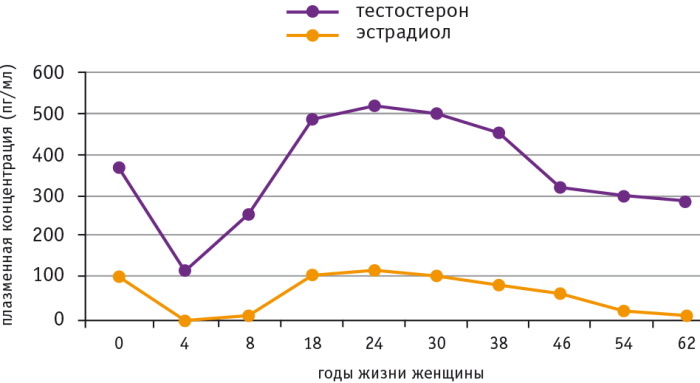
A few days before the examination, you need to refrain from intimacy, heavy physical exertion, and alcoholic beverages. Blood is donated in the morning, on an empty stomach, so you cannot eat the day before after 18:00, and even drink tea and water in the morning is prohibited. The results are compared with the values in the table.
| Age, phase of the cycle | Value (in pg / ml) |
| 15 to 45 years old | 0,45 – 3,75 |
| Average value in an adult woman | 0,29 – 3,18 |
| Ovulation period | 0,46 – 2,48 |
| Luteal phase | 0,29 – 1,73 |
| Follicle formation period | 0,45 – 3,17 |
| Before puberty | less than 0.98 |
| Menopause | 0,28 – 1,22 |
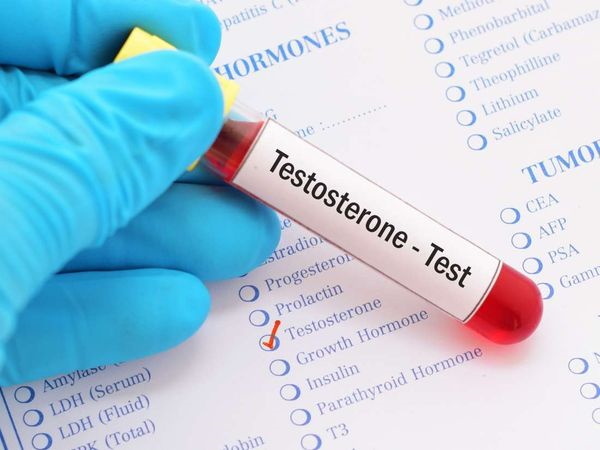 Increased testosterone in women (symptoms may be similar to the current disease) can be the result of many pathological processes. Therefore, during the diagnosis, a general examination is carried out for the presence of pathologies, which most often cause an increase in the concentration of the hormone:
Increased testosterone in women (symptoms may be similar to the current disease) can be the result of many pathological processes. Therefore, during the diagnosis, a general examination is carried out for the presence of pathologies, which most often cause an increase in the concentration of the hormone:
- pathology of the thyroid gland;
- tumors of the uterus and pituitary gland;
- kidney disease;
- ovarian dysfunction;
- malignant neoplasms.
To identify diseases, it may be necessary to pass a urine, feces, blood test for biochemistry. Of the instrumental diagnostic methods, ultrasound, mammography or X-ray are more often prescribed. If their results are not enough, then the patient is sent for CT or MRI.
During pregnancy
During pregnancy, a woman's hormonal background is disturbed. Testosterone levels in the 3rd trimester may quadruple, but this is considered normal. But if this happened in the first or second, it can lead to a frozen pregnancy, the threat of miscarriage.
Another complication is gestational diabetes, which occurs due to hormonal imbalance and metabolic disorders. This negatively affects the development of the fetus in the womb. Gestational diabetes can persist after childbirth. To exclude the disease, hormone tests are taken even during family planning.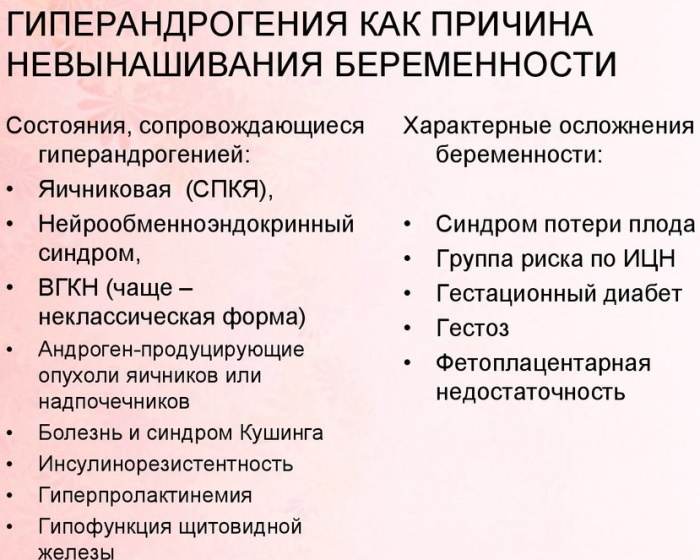
After childbirth, the indicator gradually decreases independently to its previous value. If this does not happen, treatment is necessary. With increased testosterone, the production of breast milk decreases. They stop feeding them as early as 1-1.5 months.
Drug therapy
When testosterone rises, medications are prescribed. The treatment regimen, dosage and duration of the course are prescribed by the endocrinologist. Also, medication lowering testosterone levels is performed if other methods have not worked.
Treatment is prescribed depending on the cause of the hormonal disruption:
- Disruption of the thyroid gland. With the standard treatment regimen, preparations containing iodine are prescribed (Thyrocomb, Iodtirox). But the therapy regimen is individual, it is prescribed only after the tests for hormones have been passed.
- Increased insulin levels. Prescribe a diet, intense training. From medicines - drugs that improve insulin sensitivity.
- Disruption of the adrenal glands. Hormone replacement therapy is performed. Dexamethasone, Metipred may be prescribed.
- Malfunctions of the ovaries. With polycystic disease, Metmorphine and oral contraceptives are prescribed. With inflammation of the ovaries - antibiotics, pain relievers.
- Obesity. In addition to the diet, Saxenda, Reduxin, Orlistat are prescribed.
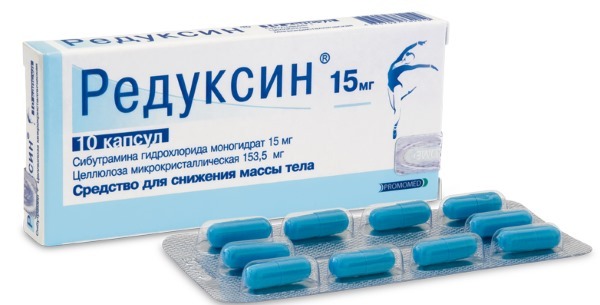
Increased testosterone is reduced with Prednisolone, Metipred, Dexametozone. But these are hormonal drugs that are prescribed only in short courses. Self-medication is prohibited, the dosage is selected by the doctor. Long-term use of drugs is contraindicated, especially during pregnancy.
Surgical operations are performed only in extreme cases. For example, if an increase in testosterone concentration occurred against the background of the development of neoplasms.
Folk remedies
Increased testosterone in women (symptoms can appear gradually) is due to stress, hard physical work, disruption of sexual life. Then you can use folk methods to lower the level of the male hormone.
They are also used if drug therapy is contraindicated or during pregnancy, when a woman cannot take medications.
Folk remedies:
- Peppermint decoction. Take 2 tbsp. l. crushed dried leaves of a plant and pour 0.4 liters of boiling water over them. Keep on low heat for 10 minutes. Then let the broth brew for another 7 minutes. The product can be drunk daily instead of tea, 2-3 times a day. The course of treatment is two weeks.
- Mint can be added to tea and dishes fresh, daily, without quantity restrictions.
- Carrot juice. It is survived from fresh root crops. To lower testosterone levels, you need to drink a glass of carrot juice daily. The maximum course of treatment is a week. If you use it longer, then it can provoke hypervitaminosis. Therefore, after 7 days, you can alternate carrot juice with freshly squeezed celery juice.
- Sage broth. Take 1 tbsp. l. chopped dry grass. Pour 250 ml of boiling water over it and cook over low heat for 5 minutes. Then let it brew for an hour, filter and divide the product into 4 equal parts. They need to be drunk during the day, 30 minutes before meals.
- Broccoli and cauliflower. These are herbal remedies that help lower testosterone levels. They can be consumed regularly, preferably steamed. This way they retain their beneficial properties. Or prepare freshly squeezed juice and drink ½ cup a day.
- Angelica. A decoction from it has a slight sedative effect, calming the nervous system, improving metabolism. At the same time, it lowers testosterone levels, restores ovarian function, and the synthesis of female hormones. To prepare the product, take 1 tbsp. l. chopped dried grass, pour it 0.3 liters of boiling water. Then cook over low heat for 10 minutes. Strain through cheesecloth and drink 50 ml, 3 times a day. The minimum course of treatment is a month.
-
Flax seeds. They are sold at the pharmacy. They need to be drunk at 1 tbsp. l. per day. After a few days, the woman will feel better. Irritability will go away, the menstrual cycle, reproductive function will be restored.

- Flaxseed infusion. It inhibits testosterone synthesis and increases estrogen production. For infusion, take 30 g of flaxseeds and pour 0.2 liters of boiling water over them. Keep in a thermos for 2 hours, then filter. Drink in the morning, on an empty stomach, ½ glass. The course of treatment is from 10 days. If necessary, the infusion can be taken longer.
- Dandelion roots. They are used fresh, washed, crushed. Then 15 g of raw materials are poured into 0.3 liters of boiling water. Keep in a thermos for 1.5 hours, then filter and drink in three doses during the day. The course of treatment is at least a week.
- A decoction of licorice root. It lowers testosterone rapidly. The components of the plant slow down the production of hormones. Therefore, you cannot drink it for a long time. The course of treatment and dosage must be adjusted by your doctor.
- Peony tincture. Take 300 g of root, washed, crushed, pour 500 ml of alcohol or vodka. The jar is tightly closed with a lid and kept in a cool place for a week. Then it is poured into a bottle with dark glass. Close with a lid and store in the refrigerator. Every day you need to drink 30 drops in the morning with water. The course of treatment is two weeks, then you need to take the same break.
- Milk thistle. Its leaves are of healing value. A decoction from it normalizes the work of baking, removes toxins and toxins from the body, and reduces the concentration of testosterone. To prepare the product, take 2 tbsp. l. crushed dry leaves and pour them 0.5 liters of boiling water. Cook over low heat for 20 minutes, stirring occasionally. Then the product is filtered through cheesecloth, cooled and drunk 200 ml per day. The course of treatment is a month. The therapy can be repeated after 30 days.
- Pumpkin seed oil. It can be consumed raw. It has no side effects. They drink oil in 1 tbsp. l. in a day. The course of treatment is at least three weeks. Regular consumption of the oil at the same time eliminates some of the symptoms of high testosterone in women. Restores the work of the digestive system, improves overall well-being, and improves immunity.
Traditional medicine recipes are an adjunct. They are taken in a long course. Before using them, you should consult your doctor. You also need to go in for sports (fitness, yoga, oriental dancing), but strong and cardio loads should be avoided. This helps to normalize hormone levels.
Diet
Increased testosterone in women (symptoms, in addition to those characteristic of this condition, can also relate to appetite) occurs with improper nutrition. For example, if strict and rigid diets are followed for a long time, when the body does not receive the necessary minerals and vitamins. Or a complete refusal of food, fasting.
Then not only the digestive system suffers, it negatively affects the work of all organs, the hormonal background and the production of hormones are disrupted. An increase in testosterone can be triggered by fatty foods, avoiding fish or meat, or excessive consumption of them.
Therefore, before drug treatment, the diet is first adjusted. It is necessary to include in it more protein foods, vegetables and fruits. You need to eat meat and fish daily (they need to be alternated). Any foods that contain sugar will inhibit testosterone production.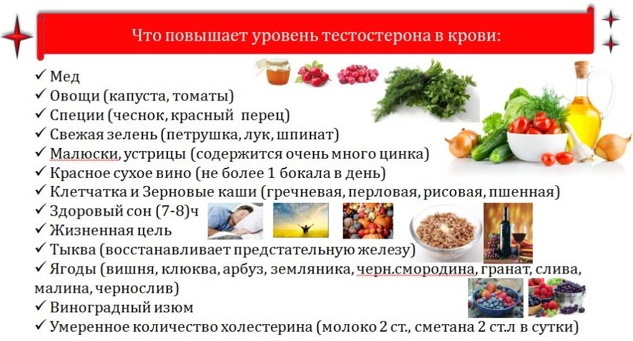
The diet should contain:
- White bread;
- pasta;
- dried fruits;
- cereals;
- cauliflower;
- juices;
- dairy;
- honey;
- linseed oil;
- apricots, apples, dates;
- milk;
- vegetable oil;
- caffeine.
Soy contains a lot of isoflavones, which greatly lower testosterone levels. And the component of daidzezn after digestion is transformed into an antiandrogen. Legumes quickly suppress testosterone synthesis. Linseed and sesame seeds contain a substance called lignan, which reduces the concentration of male hormones.
Alcohol should be avoided, as well as some foods that increase testosterone levels:
- seafood;
- liver;
- mushrooms;
- spinach;
- lamb, beef;
- salmon, sardines, mackerel;
- flax seeds;
- walnuts.
These foods can only be eaten in small quantities. With increased testosterone, they are recommended to be temporarily abandoned.
Consequences of high testosterone in women
As a result of an increase in testosterone in women, strong hair growth begins. It does not go away immediately, the process can last for years. In case of violation of the hormonal background, insomnia, irritation, and aggressive behavior appear. Often, increased appetite contributes to weight gain, which is then difficult to return to normal. Increased testosterone can lead to impaired reproductive functions, miscarriage, and infertility.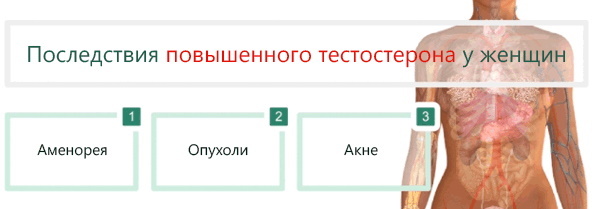
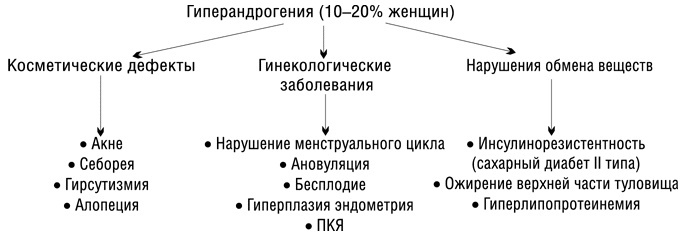
An increase in testosterone in women indicates a malfunction of the body. Additional symptoms can help determine the cause. Sometimes it is enough to eliminate stress, get enough sleep, adjust the diet or lead a regular intimate life. It is worse if the disease is the cause. Then, in order to return the level of testosterone to normal, you need to deal with the treatment of pathologies.
Video about high testosterone in women
Increased testosterone in women:


